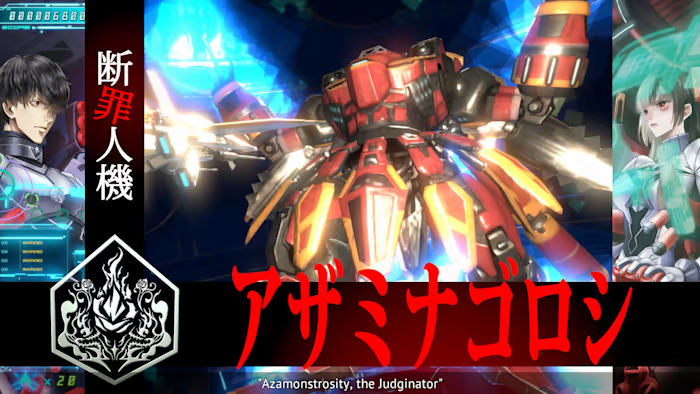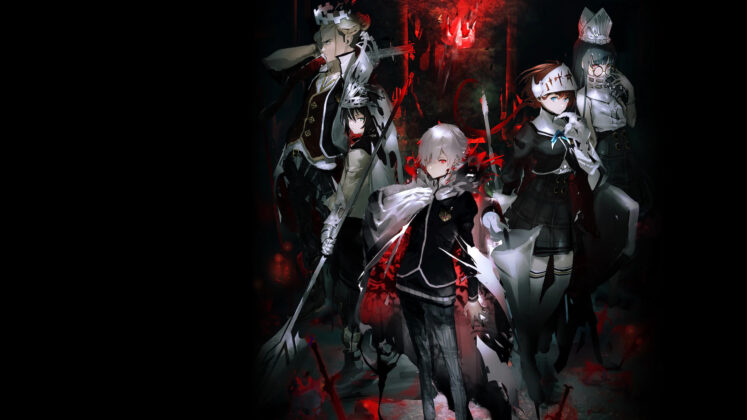A good visual novel
1 of 2 Yurukill: The Calumniation Games — NINTENDO.COM Monark — STORE.PLAYSTATION.COM Video Game Review Yurukill: The Calumniation Games Nintendo Switch Monark Sony PlayStation 5 AT the outset, it’s hard not to feel confused about what Yurukill:...

Video Game Review
Yurukill: The Calumniation Games
Nintendo Switch
Monark
Sony PlayStation 5
AT the outset, it’s hard not to feel confused about what Yurukill: The Calumniation Games attempts to do. Its quirky over-the-top nature might seem forced the first time you look at it, especially when you get to its gameplay mechanics. It’s a visual novel, filled with escape room segments, all while being interspersed with a solid shoot-’em-up minigame. That is not a combination you’ll often find, and, at times, the pacing does seem a little off. However, if you set aside your initial misgivings, you’ll see that the game has far more going for it despite its weirdness, and that while it doesn’t excel at any particular thing, it does do a superb job at balancing the different genres to keep things lively.
Yurukill: The Calumniation Games follows the story of Sengoku Shinju, a man who’s been framed for the deaths of 21 people. His chance for freedom, however, arrives in the form of Binko, a mysterious woman who offers him a chance to redeem himself. All he has to do is participate in some games in an eccentric location known only as Yurukill land. These are no simple games, though; in Yurukill land, winning might mean total freedom, but it’s rife with danger for the unwary. A simple misstep could spell disaster, and when Shinju’s closest partner is someone who has it out for him, it’s not going to be as easy as it seems.
This concept is what propels much of the story of Yurukill: The Calumniation Games. There are interesting dynamics to be explored with each character, as they all have their own agendas and goals to fulfil. The tension is always present because of this, especially in the scenes where prisoners and their partners are involved. There’s a clear power imbalance at play, and this creates great friction that allows each character’s story to develop, especially when it gets emotionally charged in the game’s more dramatic moments. These dramatic moments also extend to other portions of the game, particularly in its escape room segments. They share the same quirky, weird personality that Yurukill land has to offer, but do so in a way that makes each puzzle feel unique. Each problem you have to solve in these sequences has its own internal logic, setup, and solution, and this gives it a strong personality that manages to make these sequences memorable.
To be sure, the escape room segments in Yurukill: The Calumniation Games are far from challenging. Each puzzle can be figured out pretty easily, and the hint system that can be availed of doesn’t penalize players who use it. In fact, it seems almost expected for you to experiment with it, as the dialogues these hints have are fun and reveal more about the characters and how they view the trials they face. In a lot of ways, these puzzle segments seem like the developers’ way to break up long visual novel segments of just pure reading.
This, however, does not extend to the shoot-’em-up segments of Yurukill: The Calumniation Games. While the game in the easy setting is actually pretty, the harder modes are where the challenges really amp up. The game certainly isn’t shy on throwing trying stages at you. The characters you have available to choose from all have their own strengths and gimmicks, and the differences in their playstyle actually have an impact on how smoothly you can proceed depending on what kind of power-ups you prefer. It doesn’t do much new in the shmup (shoot-’em-up) genre, but it does things well enough to make it actually enjoyable. Colorful lights shoot at you, dozens of projectiles home in, and plenty of powerups can be discovered and enjoyed to counter these.
That’s Yurukill: The Calumniation Games in a nutshell. You rotate between its three game modes, mainly getting story beats through its visual novel side to tell you more about its sinister plot. The puzzle and the shoot-’em-up segments pop in now and then to break up the long reading bouts, occasionally chiming in with story details or small plot-related anecdotes that help smoothen the experience. And, honestly, while it might not strive to be more, it does what it has set out to do. All of its parts, when played, are equally satisfying, and the main hurdle the game has isn’t in its lack of quality; it’s in finding an audience that’s willing to accept this mish-mash of genres to really dig deep into its story. Granted, parts of the narrative do drag a little, especially in the beginning when it has to establish its important plot points, but the rest of the story is able to keep up its pace to a satisfying degree.
Yurukill: The Calumniation Games is best when it’s able to suck you into its world this way. Its great soundtrack mixes with its strong presentation and its personality, and it embraces the inherent silliness of its premise. Even so, it manages to still keep its sharper edge when it needs to, forming a story that is, at its core, a mystery surrounded by characters you’d really like to see triumph. When it plays to these strengths, it highlights its best parts quite well, especially if you enjoy the themes it has at play.
The overall package of Yurukill: The Calumniation Games does give you enough content to really dig your teeth into, with a lengthy story mode to uncover, and its shmup side adding on to the replay value with its arcade mode. Your first run will really have you engrossed in its story and its characters, and its premise is enough to draw you in to appreciate its other modes. While it does have some minor issues on the Nintendo Switch (especially when the screen goes crazy with its visual effects), these barely detract from the singular experience it’s providing, and any fan of a good visual novel will find a place for it in his or her collection.
THE GOOD:
• Interesting genre mix of story, puzzle, and action gameplay
• Likeable characters with a tense and interesting premise
• Good artstyle and sprite design, combined with a strong visual flair during its shmup segments
THE BAD:
• Minor performance issues during tenser segments can be annoying
• Escape room segments are a bit too easy (and are impossible to fail due to the hint system in place)
• The story’s slow start may feel boring compared to its more developed plotlines later on
RATING: 8.5/10
POSTSCRIPT: Underneath Monark’s solid horror motif, there’s a ton of things to love. What looks like an overly edgy concept actually belies its strong role-playing-game mechanics. When combined with its slick, gothic vibe and smooth gameplay, it manages to hold its own in time. Though it has its flaws, particularly in its story, its presentation and gameplay is topnotch. And while some of its mechanics might throw you off, the way the game paces itself ensures that you land on your feet all the same.
In Monark, you play as a student from the Shin Mikado Academy. No ordinary school, Shin Mikado is enveloped by a mist that slowly drives its student populace mad. These mists are powered by demons, and these demons are your targets. You must team up with a ragtag group of misfits to bring them down before they cause too much undue harm. Along the way, you learn more about what you’re facing, talk and bond with your companions, and see their stories as well as that of the school you’re enrolled in unfold.
Monark does not really break new ground in terms of storytelling, especially when other Japanese RPGs start so similarly. However, it is able to keep things interesting through its unique features, particularly with its motifs in place. Borrowing heavily from dark, gothic imagery, each of the characters you will eventually use is symbolized by one of the seven deadly sins, and their backstories are tied to this. Each has his or her own personal demons to conquer, and have his or her own arc to go through. What’s more, there’s a slew of options you can choose to influence how the characters end up, which eventually leads down to diverging routes and storytelling differences that make you feel like you have an impact on what’s happening. These choices also directly affect what ending you’ll get, incentivizing repeat playthroughs in modes like NG+ to see all the content. Even your own personal character isn’t one pre-built into the story. You craft him or her yourself, influenced through a cryptic questionnaire you answer early on that changes what kind of skills he or she has. While this may seem minor, it’s the little touches like this that allow for a more personalized playthrough that feels unique to each person who picks it up.
The writing quality in Monark is, at the very least, competent. While the initial setup of the story may feel sluggish, a lot of it is deliberately meant to set the grim tone of the narrative. At times, it may even feel a little too depressing, as it strays away from moments of levity to dwell on darker emotions that may leave people feeling uncomfortable. While the game handles these topics tastefully, not many titles tackle these sorts of issues, and they frequently come up in the form of puzzles you need to finish, or enemies you need to beat down.
Meanwhile, the combat is anything but dour. Monark’s battles are where it really shines, asking you not only to make good use of your skills, but also to manage certain resources to make the most out of its systems. A lot of it will come naturally, of course; proper skill usage, proper positioning, proper use of buffs, debuffs, and heals — these are all concepts other JRPGs use. However, Monark adds in an additional layer through its Madness system. Misuse of it can both be beneficial and disastrous, as characters in the madness state not only get a tremendous buff to their damage potential; they also go berserk and attack the closest targets available. While a maddened party member will eventually die out when enough turns have passed, the provision allows you to pull off some very crazy combo potentials at the cost of risky moves. A similar effect can also be achieved by instead getting into an Awakened status, which also boosts your stats but doesn’t lose you control of your units. If you manage to achieve both at the same time, you become incredibly powerful, stacking both bonuses while still retaining full control of your character.
This might seem like a little thing, but this extra management you have to do in Monark means so much when skills either cost health or increase your madness bar. You’re always juggling whether to use up your health or if you’re fine with getting a little closer to going crazy, all while being swarmed by enemies who, while not exactly smart, are relentless in their aggression. Combat encounters will always necessitate this balance, and even during the slower segments of grinding away for levels and items, it’s always in the back of your mind just how much you’re willing to push yourself to make this fight a little easier.
This type of combat system does come with a cost, however. While it is engaging, it can also be draining, particularly in how the later enemies scale. Levels aren’t a suggestion so much as a necessity, and, more often than not, you’ll find yourself tempted to grind away for more stats. While easy to do, it suffers from the repetitiveness of having to do it in the first place. And while the story motif and environments hold up the first time through, they don’t remain that way once you have to repeat your trek through these dungeons with the hope of levelling up.
On the whole, this is pretty much the core concern of Monark. While it has some grand ideas about what it wants to do, its pacing suffers, not just from its mechanics but also from the design of its story. It’s meant to be a slow burn, but the decision comes at the cost — and to the point where the dragging moments may put down some of its well-thought-out aspects.
On the whole, Monark really succeeds at what it tries to do, but runs into some issues that some may not be okay with. That said, its uniqueness stands out. It’s not just an edgy JRPG riding on its inspirations; it’s got a lot of content to offer, and a lot of combat to enjoy.
THE GOOD:
• Enjoyable (if depressing and dark) story writing
• Well-thought-out combat system that rewards careful planning, and enables aggressiveness
• Lots of content on offer, with multiple endings to unlock
THE BAD:
• Questionable pacing, especially at the start of the game
• Enemies are more numerous than competent, which can lead to some dragging encounters in the later parts (particularly if you’re underleveled)
• Its tactical combat can feel repetitive during grinding
It’s not often that a title like Submerged gets to hit store shelves. While walking sims are still relatively popular, Submerged just manages to slip into that category due to how it’s presented, and your initial impressions of it might lead you to think otherwise. However, it does play out differently from others of its genre. Framed like an adventure game, Submerged is a short but sweet experience, focusing mainly on themes of exploration and family. Revolving around saving the life of your younger sibling, Submerged offers very little else other than this premise, and you’ll slowly be drawn into its surprisingly competent atmosphere. While it doesn’t take long to beat and is not very complicated, it does have a few interesting qualities to it that help keep it interesting all the way to the end.
Submerged’s story is pretty simple as it is. You are your brother’s caretaker, and you must find a way to help his injuries before they worsen. This means exploring the ruined city to its fullest, and finding what you can scavenge in its abandoned ruins. In the process, however, you must make use of your boat to travel around its flooded parts to find supplies, and to do some parkour and climbing to reach higher areas the water has not reached. While not much story is initially revealed, there’s a surprising amount of personality here on offer, particularly in the ruins you’re tasked to explore, where you traverse all sorts of abandoned buildings and overgrown sections.
This is the real meat of the experience. As you look into what Submerged has to offer, you discover that it has something beyond what the genre normally offers. Admittedly, it isn’t really much, not when games like Subliminal or The Stanley Parable offer a more dynamic experience. But, even then, there’s still something to appreciate. How you move from area to area is pretty smooth, making exploration feel seamless and satisfying, and you’ll check out all sorts of locations of interest, looking for whatever collectibles you can find. There are no enemies to fight or quick-time events to play out. You’re simply there for the ride.
While this might sound boring, it’s the environment that really makes its mark in Submerged, and the little mysteries it sets up when you encounter all sorts of creatures and locations overcome the lack of concrete storytelling the game normally gives out. Getting to explore the city to its fullest and piecing together its mysteries while looking out at its decayed exteriors is something most games dare not try, and it is stunning in how this little independent title seeks to pull this off. Its graphics are not stunning by any means, but the way it frames each location makes up for its shortcomings, especially with the way it manages to make the horizon work in tandem with the images you’re seeing. It frames areas you look at and arrays them against the bigger backdrop of the overall landscape, and honestly, it looks absolutely gorgeous despite the low-quality models on hand. There’s a timeless charm it manages to capture, and it adds a distinct feel to the ruins you have to look for – almost as if you’re intruding on something that has been long forgotten. Especially when the music hits and sets the tone so well.
However, while exploration is Submerged’s greatest asset, it also leads to the game’s dizzying lows. There’s a very unpolished feel to it at times, particularly in the animations which come off as very raw and simple by comparison. It’s nothing too out of the ordinary given the budget, but it does detract from the majesty of what you’re seeing. If anything, the real danger is in how it can feel so boring at times. Submerged is a walking simulator, and while it might hide that fact, once you realize it, it loses a bit of its mystery. Nothing hurts or harms you, and an adventure with no inherent danger is a story with no stakes. And with few real twists to look forward to, the mystery behind everything breaks down, because, really, what are you scared of in the ruins when nothing hinders your path?
Submerged is a short game, and while you can return to look for missing collectibles, it’s safe to say it’s not a title you’ll spend much time on, even if you do go for 100% completion. It lacks the ambition to go further with its premise, and while it’s an admirable little title that tries to achieve much, it cannot hold a candle to the initial expectations it sets. It’s a nice little distraction, but yo’’ll play it, finish it, and move on to greener pastures before long.
THE GOOD
•Great music and interesting premise
•Nice environments and backdrops to explore
•Surprisingly atmospheric, with a story revolving around family and sacrifice
THE BAD:
• Short and sweet experience, with low replay value
• No challenge to it at any point, with not very memorable story beats compared to the grander mystery of the ruins you explore
• Low budget and rough character models contrast greatly with more picturesque environment
THE LAST WORD: 2K Sports has announced that Suns shooting guard Devin Booker will be featured on the cover of NBA 2K23.
The three-time NBA All-Star and 2021-22 Kia All-NBA First Team selection will appear on this year’s Standard Edition and cross-generation Digital Deluxe Edition. Meanwhile, living legend Michael Jordan will appear on — what else? — the NBA 2K23 Michael Jordan Edition and the limited NBA 2K23 Championship Edition. On the distaff side, all-time WNBA greats Diana Taurasi and Sue Bird will appear on the limited WNBA Edition.
NBA 2K23 will also reintroduce The Jordan Challenge, which encourages players to recreate 15 iconic moments from Jordan’s illustrious career. All four editions of the game will be available in digital and physical formats. Pre-orders have started, with the worldwide release scheduled for Sept. 9.

























